State Space Search in Artificial Intelligence
State space search is a problem-solving technique used in Artificial Intelligence (AI) to find the solution path from the initial state to the goal state by exploring the various states. The state space search approach searches through all possible states of a problem to find a solution. It is an essential part of Artificial Intelligence and is used in various applications, from game-playing algorithms to natural language processing.

Introduction
A state space is a way to mathematically represent a problem by defining all the possible states in which the problem can be. This is used in search algorithms to represent the initial state, goal state, and current state of the problem. Each state in the state space is represented using a set of variables.
The efficiency of the search algorithm greatly depends on the size of the state space, and it is important to choose an appropriate representation and search strategy to search the state space efficiently.
One of the most well-known state space search algorithms is the A algorithm. Other commonly used state space search algorithms include breadth-first search (BFS) , depth-first search (DFS) , hill climbing , simulated annealing , and genetic algorithms .
Features of State Space Search
State space search has several features that make it an effective problem-solving technique in Artificial Intelligence. These features include:
Exhaustiveness: State space search explores all possible states of a problem to find a solution.
Completeness: If a solution exists, state space search will find it.
Optimality: Searching through a state space results in an optimal solution.
Uninformed and Informed Search: State space search in artificial intelligence can be classified as uninformed if it provides additional information about the problem.
In contrast, informed search uses additional information, such as heuristics, to guide the search process.
Steps in State Space Search
The steps involved in state space search are as follows:

- To begin the search process, we set the current state to the initial state.
- We then check if the current state is the goal state. If it is, we terminate the algorithm and return the result.
- If the current state is not the goal state, we generate the set of possible successor states that can be reached from the current state.
- For each successor state, we check if it has already been visited. If it has, we skip it, else we add it to the queue of states to be visited.
- Next, we set the next state in the queue as the current state and check if it's the goal state. If it is, we return the result. If not, we repeat the previous step until we find the goal state or explore all the states.
- If all possible states have been explored and the goal state still needs to be found, we return with no solution.
State Space Representation
State space Representation involves defining an INITIAL STATE and a GOAL STATE and then determining a sequence of actions, called states, to follow.
- State: A state can be an Initial State, a Goal State, or any other possible state that can be generated by applying rules between them.
- Space: In an AI problem, space refers to the exhaustive collection of all conceivable states.
- Search: This technique moves from the beginning state to the desired state by applying good rules while traversing the space of all possible states.
- Search Tree: To visualize the search issue, a search tree is used, which is a tree-like structure that represents the problem. The initial state is represented by the root node of the search tree, which is the starting point of the tree.
- Transition Model: This describes what each action does, while Path Cost assigns a cost value to each path, an activity sequence that connects the beginning node to the end node. The optimal option has the lowest cost among all alternatives.
Example of State Space Search
The 8-puzzle problem is a commonly used example of a state space search. It is a sliding puzzle game consisting of 8 numbered tiles arranged in a 3x3 grid and one blank space. The game aims to rearrange the tiles from their initial state to a final goal state by sliding them into the blank space.
To represent the state space in this problem, we use the nine tiles in the puzzle and their respective positions in the grid. Each state in the state space is represented by a 3x3 array with values ranging from 1 to 8 , and the blank space is represented as an empty tile.
The initial state of the puzzle represents the starting configuration of the tiles, while the goal state represents the desired configuration. Search algorithms utilize the state space to find a sequence of moves that will transform the initial state into the goal state.

This algorithm guarantees a solution but can become very slow for larger state spaces. Alternatively, other algorithms, such as A search , use heuristics to guide the search more efficiently.
Our objective is to move from the current state to the target state by sliding the numbered tiles through the blank space. Let's look closer at reaching the target state from the current state.

To summarize, our approach involved exhaustively exploring all reachable states from the current state and checking if any of these states matched the target state.
Applications of State Space Search
- State space search algorithms are used in various fields, such as robotics, game playing, computer networks, operations research, bioinformatics, cryptography, and supply chain management. In artificial intelligence, state space search algorithms can solve problems like pathfinding , planning , and scheduling .
- They are also useful in planning robot motion and finding the best sequence of actions to achieve a goal. In games, state space search algorithms can help determine the best move for a player given a particular game state.
- State space search algorithms can optimize routing and resource allocation in computer networks and operations research.
- In Bioinformatics , state space search algorithms can help find patterns in biological data and predict protein structures.
- In Cryptography , state space search algorithms are used to break codes and find cryptographic keys.
- State Space Search is a problem-solving technique used in AI to find a solution to a problem by exploring all possible states of the problem.
- It is an exhaustive, complete, and optimal search process that can be classified as uninformed or informed.
- State Space Representation is a crucial step in the state space search process as it determines the efficiency of the search algorithm.
- State space search in artificial intelligence has several applications, including game-playing algorithms, natural language processing, robotics, planning, scheduling, and computer vision.
State Space Search

State Space Representation in Artificial Intelligence
Problem statement: explain state splace reseach in ai with example.
To find solution to any problem the foremost condition is that it has to be precisely defined or represented. By defining it precisely means to present an abstract problem in real workable states that are really understood. These states are then operated by some set of operators and finally the solution is obtained. The decision of which operator is to be applied is taken by the control strategy used. There are two ways in which the AI problem can be represented.
State Space Representation
- Problem Reduction
State Space Representation consist of defining an INITIAL State (from where to start), the GOAL State (The destination) and then we follow certain set of sequence of steps (called States). Let’s define each of them separately.
State : AI problem can be represented as a well formed set of possible states. State can be Initial State i.e. starting point, Goal State i.e. destination point and various other possible states between them which are formed by applying certain set of rules.
Space : In an AI problem the exhaustive set of all possible states is called space.
Search : In simple words search is a technique which takes the initial state to goal state by applying certain set of valid rules while moving through space of all possible states.
So we can say that to do a search process we need the following.
- Initial State
- Set of valid Rules
So, a set of all possible states for a given problem is known as state space representation of the problem.
For example: In chess game: The initial position of all the pieces on a chess board defines the initial state. The rules of playing chess defines the set of legal rules and Goal state is defined by any possible board position corresponding to checkmate or a draw state. The point to be noted here is that there can be more than one Goal state possible.
State Space Representation of Tic Tac Toe game is shown is the following figure. Starting from the initial state as we move on applying rules of putting X (cross) or O (Zero) we keep on generating the states, hence the set of states all such generated states is called space, unless we reach one of the goal states that can be a win situation or a draw situation. The new state is generated from the earlier one is by applying the a control strategy.
State Space Representation of Tic Tac Toe Game

State space representation are very advantageous in AI problems as the whole state space is given it becomes easy to find the solution path that leads from initial state to goal state. The basic job is to create such algorithms which can search through the problem space and find out the best solution path. Later chapters will discuss about these search procedures and control strategy to move through the space.
- ← AI Technique
- Production Systems in AI →
We have disabled - Right- Click - How about stay to read :)
- Data Science
- Data Analysis
- Data Visualization
- Machine Learning
- Deep Learning
- Computer Vision
- Artificial Intelligence
- AI ML DS Interview Series
- AI ML DS Projects series
- Data Engineering
- Web Scrapping
Search Algorithms in AI
Artificial Intelligence is the study of building agents that act rationally. Most of the time, these agents perform some kind of search algorithm in the background in order to achieve their tasks.
- A State Space. Set of all possible states where you can be.
- A Start State. The state from where the search begins.
- A Goal State. A function that looks at the current state returns whether or not it is the goal state.
- The Solution to a search problem is a sequence of actions, called the plan that transforms the start state to the goal state.
- This plan is achieved through search algorithms.
Types of search algorithms:
There are far too many powerful search algorithms out there to fit in a single article. Instead, this article will discuss six of the fundamental search algorithms, divided into two categories, as shown below.
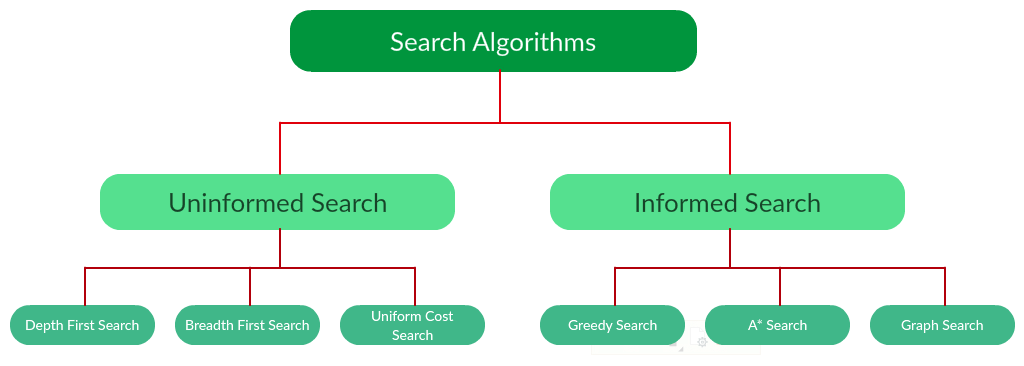
Note that there is much more to search algorithms than the chart I have provided above. However, this article will mostly stick to the above chart, exploring the algorithms given there.
Uninformed Search Algorithms:
The search algorithms in this section have no additional information on the goal node other than the one provided in the problem definition. The plans to reach the goal state from the start state differ only by the order and/or length of actions. Uninformed search is also called Blind search . These algorithms can only generate the successors and differentiate between the goal state and non goal state. The following uninformed search algorithms are discussed in this section.
- Depth First Search
- Breadth First Search
- Uniform Cost Search
Each of these algorithms will have:
- A problem graph, containing the start node S and the goal node G.
- A strategy, describing the manner in which the graph will be traversed to get to G.
- A fringe, which is a data structure used to store all the possible states (nodes) that you can go from the current states.
- A tree, that results while traversing to the goal node.
- A solution plan, which the sequence of nodes from S to G.
Depth First Search :
Depth-first search (DFS) is an algorithm for traversing or searching tree or graph data structures. The algorithm starts at the root node (selecting some arbitrary node as the root node in the case of a graph) and explores as far as possible along each branch before backtracking. It uses last in- first-out strategy and hence it is implemented using a stack. Example:
Question. Which solution would DFS find to move from node S to node G if run on the graph below?
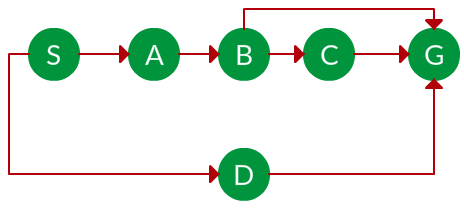
Solution. The equivalent search tree for the above graph is as follows. As DFS traverses the tree “deepest node first”, it would always pick the deeper branch until it reaches the solution (or it runs out of nodes, and goes to the next branch). The traversal is shown in blue arrows.
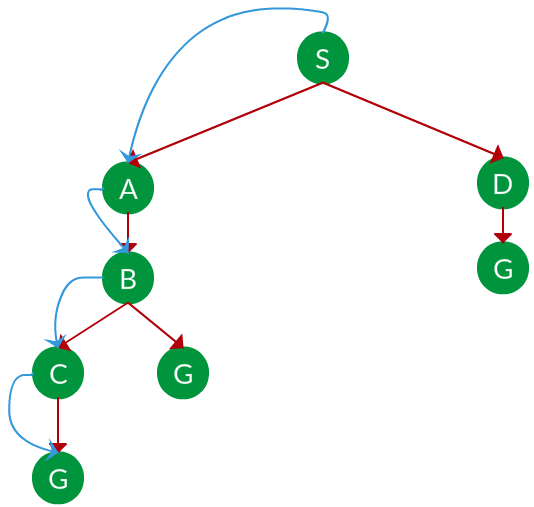
Path: S -> A -> B -> C -> G
= the depth of the search tree = the number of levels of the search tree. = number of nodes in level . Time complexity: Equivalent to the number of nodes traversed in DFS. Space complexity: Equivalent to how large can the fringe get. Completeness: DFS is complete if the search tree is finite, meaning for a given finite search tree, DFS will come up with a solution if it exists. Optimality: DFS is not optimal, meaning the number of steps in reaching the solution, or the cost spent in reaching it is high.

Breadth First Search :
Breadth-first search (BFS) is an algorithm for traversing or searching tree or graph data structures. It starts at the tree root (or some arbitrary node of a graph, sometimes referred to as a ‘search key’), and explores all of the neighbor nodes at the present depth prior to moving on to the nodes at the next depth level. It is implemented using a queue. Example: Question. Which solution would BFS find to move from node S to node G if run on the graph below?

Solution. The equivalent search tree for the above graph is as follows. As BFS traverses the tree “shallowest node first”, it would always pick the shallower branch until it reaches the solution (or it runs out of nodes, and goes to the next branch). The traversal is shown in blue arrows.
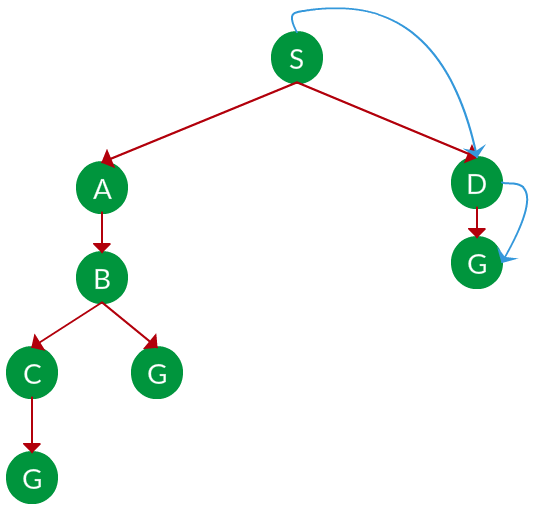
Path: S -> D -> G
= the depth of the shallowest solution. = number of nodes in level . Time complexity: Equivalent to the number of nodes traversed in BFS until the shallowest solution. Space complexity: Equivalent to how large can the fringe get. Completeness: BFS is complete, meaning for a given search tree, BFS will come up with a solution if it exists. Optimality: BFS is optimal as long as the costs of all edges are equal.
Uniform Cost Search:
UCS is different from BFS and DFS because here the costs come into play. In other words, traversing via different edges might not have the same cost. The goal is to find a path where the cumulative sum of costs is the least. Cost of a node is defined as:
Example: Question. Which solution would UCS find to move from node S to node G if run on the graph below?
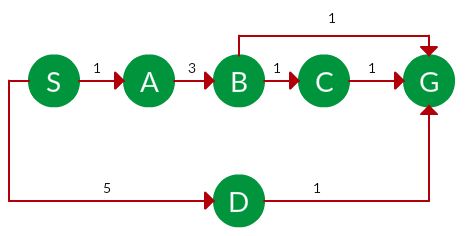
Solution. The equivalent search tree for the above graph is as follows. The cost of each node is the cumulative cost of reaching that node from the root. Based on the UCS strategy, the path with the least cumulative cost is chosen. Note that due to the many options in the fringe, the algorithm explores most of them so long as their cost is low, and discards them when a lower-cost path is found; these discarded traversals are not shown below. The actual traversal is shown in blue.
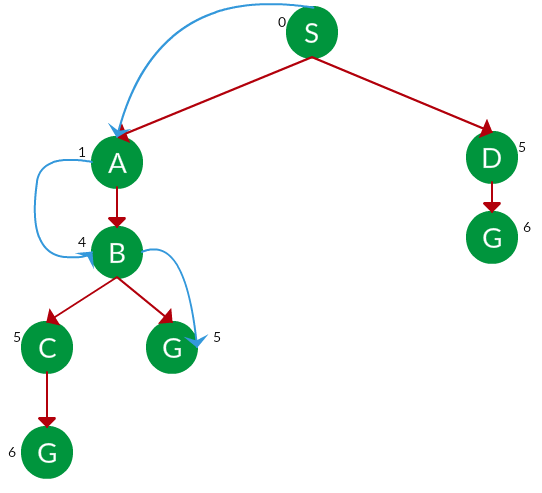
Path: S -> A -> B -> G Cost: 5 Let = cost of solution. = arcs cost. Then effective depth Time complexity: , Space complexity:
Advantages:
- UCS is complete only if states are finite and there should be no loop with zero weight.
- UCS is optimal only if there is no negative cost.
Disadvantages:
- Explores options in every “direction”.
- No information on goal location.
Informed Search Algorithms:
Here, the algorithms have information on the goal state, which helps in more efficient searching. This information is obtained by something called a heuristic. In this section, we will discuss the following search algorithms.
- Greedy Search
- A* Tree Search
- A* Graph Search
Search Heuristics: In an informed search, a heuristic is a function that estimates how close a state is to the goal state. For example – Manhattan distance, Euclidean distance, etc. (Lesser the distance, closer the goal.) Different heuristics are used in different informed algorithms discussed below.
Greedy Search:
In greedy search, we expand the node closest to the goal node. The “closeness” is estimated by a heuristic h(x). Heuristic: A heuristic h is defined as- h(x) = Estimate of distance of node x from the goal node. Lower the value of h(x), closer is the node from the goal. Strategy: Expand the node closest to the goal state, i.e. expand the node with a lower h value. Example:
Question. Find the path from S to G using greedy search. The heuristic values h of each node below the name of the node.
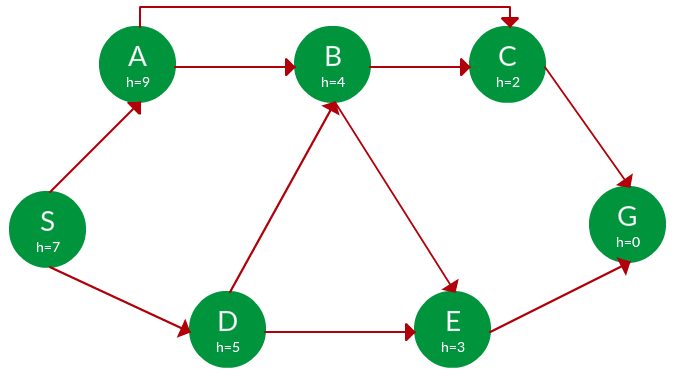
Solution. Starting from S, we can traverse to A(h=9) or D(h=5). We choose D, as it has the lower heuristic cost. Now from D, we can move to B(h=4) or E(h=3). We choose E with a lower heuristic cost. Finally, from E, we go to G(h=0). This entire traversal is shown in the search tree below, in blue.
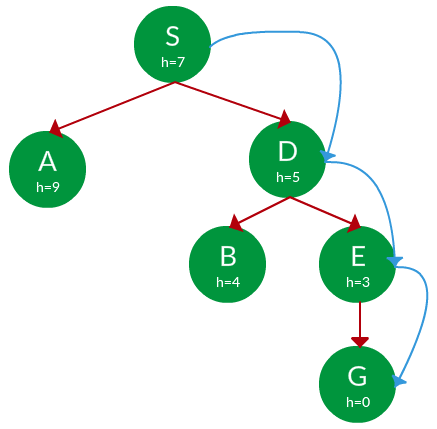
Path: S -> D -> E -> G
Advantage: Works well with informed search problems, with fewer steps to reach a goal. Disadvantage: Can turn into unguided DFS in the worst case.
A* Tree Search:
- Here, h(x) is called the forward cost and is an estimate of the distance of the current node from the goal node.
- And, g(x) is called the backward cost and is the cumulative cost of a node from the root node.
- A* search is optimal only when for all nodes, the forward cost for a node h(x) underestimates the actual cost h*(x) to reach the goal. This property of A* heuristic is called admissibility .
Strategy: Choose the node with the lowest f(x) value. Example:
Question. Find the path to reach from S to G using A* search.
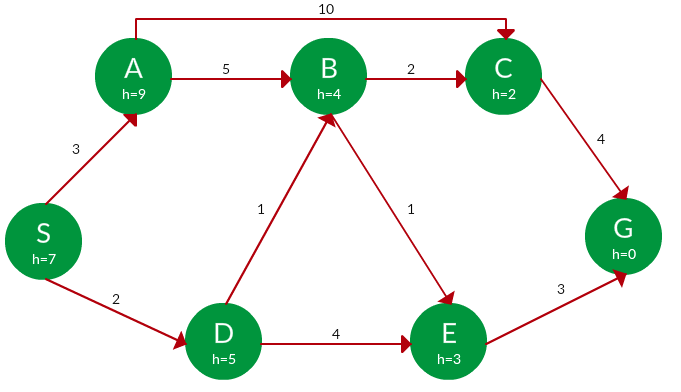
Solution. Starting from S, the algorithm computes g(x) + h(x) for all nodes in the fringe at each step, choosing the node with the lowest sum. The entire work is shown in the table below. Note that in the fourth set of iterations, we get two paths with equal summed cost f(x), so we expand them both in the next set. The path with a lower cost on further expansion is the chosen path.
A* Graph Search :
- A* tree search works well, except that it takes time re-exploring the branches it has already explored. In other words, if the same node has expanded twice in different branches of the search tree, A* search might explore both of those branches, thus wasting time
- A* Graph Search, or simply Graph Search, removes this limitation by adding this rule: do not expand the same node more than once.
- Heuristic. Graph search is optimal only when the forward cost between two successive nodes A and B, given by h(A) – h (B), is less than or equal to the backward cost between those two nodes g(A -> B). This property of the graph search heuristic is called consistency .
Question. Use graph searches to find paths from S to G in the following graph.

the Solution. We solve this question pretty much the same way we solved last question, but in this case, we keep a track of nodes explored so that we don’t re-explore them.
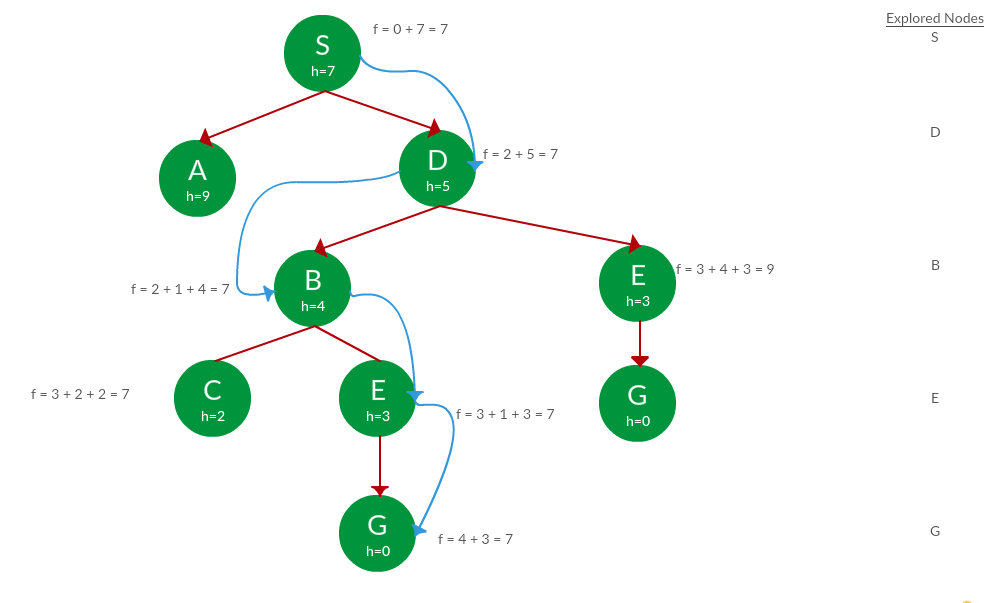
Path: S -> D -> B -> E -> G Cost: 7
Similar Reads
- Artificial Intelligence Tutorial | AI Tutorial Artificial Intelligence (AI) refers to the simulation of human intelligence in machines that are programmed to think and act like humans. It involves the development of algorithms and computer programs that can perform tasks that typically require human intelligence such as visual perception, speech 15 min read
- What is Artificial Intelligence? What is Artificial Intelligence? In today's rapidly advancing technological landscape, AI has become a household term. From chatbots and virtual assistants to self-driving cars and recommendation algorithms, the impact of AI is ubiquitous. But what exactly is AI and how does it work? At its core, Ar 15+ min read
- History of AI The term Artificial Intelligence (AI) is already widely used in everything from smartphones to self-driving cars. AI has come a long way from science fiction stories to practical uses. Yet What is artificial intelligence and how did it go from being an idea in science fiction to a technology that re 7 min read
Types of AI
- Types of Artificial Intelligence (AI) Artificial Intelligence refers to something which is made by humans or non-natural things and Intelligence means the ability to understand or think. AI is not a system but it is implemented in the system. There are many different types of AI, each with its own strengths and weaknesses. This article 6 min read
- Types of AI Based on Capabilities: An In-Depth Exploration Artificial Intelligence (AI) is not just a single entity but encompasses a wide range of systems and technologies with varying levels of capabilities. To understand the full potential and limitations of AI, it's important to categorize it based on its capabilities. This article delves into the diffe 5 min read
- Types of AI Based on Functionalities Artificial Intelligence (AI) has become an integral part of modern technology, influencing everything from how we interact with our devices to how businesses operate. However, AI is not a monolithic concept; it can be classified into different types based on its functionalities. Understanding these 7 min read
- Agents in Artificial Intelligence In artificial intelligence, an agent is a computer program or system that is designed to perceive its environment, make decisions and take actions to achieve a specific goal or set of goals. The agent operates autonomously, meaning it is not directly controlled by a human operator. Agents can be cla 11 min read
Problem Solving in AI
- Search Algorithms in AI Artificial Intelligence is the study of building agents that act rationally. Most of the time, these agents perform some kind of search algorithm in the background in order to achieve their tasks. A search problem consists of: A State Space. Set of all possible states where you can be.A Start State. 10 min read
- Uninformed Search Algorithms in AI Uninformed search algorithms are a class of search algorithms that do not have any additional information about the problem other than what is given in the problem definition. They are also known as blind search algorithms. In Artificial Intelligence (AI), search algorithms play a crucial role in fi 8 min read
- Informed Search Algorithms in Artificial Intelligence Informed search algorithms, also known as heuristic search algorithms, are an essential component of Artificial Intelligence (AI). These algorithms use domain-specific knowledge to improve the efficiency of the search process, leading to faster and more optimal solutions compared to uninformed searc 10 min read
- Local Search Algorithm in Artificial Intelligence Local search algorithms are essential tools in artificial intelligence and optimization, employed to find high-quality solutions in large and complex problem spaces. Key algorithms include Hill-Climbing Search, Simulated Annealing, Local Beam Search, Genetic Algorithms, and Tabu Search. Each of thes 4 min read
- Adversarial Search Algorithms in Artificial Intelligence (AI) Adversarial search algorithms are the backbone of strategic decision-making in artificial intelligence, it enables the agents to navigate competitive scenarios effectively. This article offers concise yet comprehensive advantages of these algorithms from their foundational principles to practical ap 15+ min read
- Constraint Satisfaction Problems (CSP) in Artificial Intelligence Constraint Satisfaction Problems (CSP) play a crucial role in artificial intelligence (AI) as they help solve various problems that require decision-making under certain constraints. CSPs represent a class of problems where the goal is to find a solution that satisfies a set of constraints. These pr 14 min read
Knowledge, Reasoning and Planning in AI
- How do knowledge representation and reasoning techniques support intelligent systems? In artificial intelligence (AI), knowledge representation and reasoning (KR&R) stands as a fundamental pillar, crucial for enabling machines to emulate complex decision-making and problem-solving abilities akin to those of humans. This article explores the intricate relationship between KR&R 5 min read
- First-Order Logic in Artificial Intelligence First-order logic (FOL), also known as predicate logic or first-order predicate calculus, is a powerful framework used in various fields such as mathematics, philosophy, linguistics, and computer science. In artificial intelligence (AI), FOL plays a crucial role in knowledge representation, automate 6 min read
- Types of Reasoning in Artificial Intelligence In today's tech-driven world, machines are being designed to mimic human intelligence and actions. One key aspect of this is reasoning, a logical process that enables machines to conclude, make predictions, and solve problems just like humans. Artificial Intelligence (AI) employs various types of re 6 min read
- What is the Role of Planning in Artificial Intelligence? Artificial Intelligence (AI) is reshaping the future, playing a pivotal role in domains like intelligent robotics, self-driving cars, and smart cities. At the heart of AI systems’ ability to perform tasks autonomously is AI planning, which is critical in guiding AI systems to make informed decisions 7 min read
- Representing Knowledge in an Uncertain Domain in AI Artificial Intelligence (AI) systems often operate in environments where uncertainty is a fundamental aspect. Representing and reasoning about knowledge in such uncertain domains is crucial for building robust and intelligent systems. This article explores the various methods and techniques used in 6 min read
Learning in AI
- Supervised Machine Learning Supervised machine learning is a fundamental approach for machine learning and artificial intelligence. It involves training a model using labeled data, where each input comes with a corresponding correct output. The process is like a teacher guiding a student—hence the term "supervised" learning. I 12 min read
- Unsupervised Learning Unsupervised learning is a branch of machine learning that deals with unlabeled data. Unlike supervised learning, where the data is labeled with a specific category or outcome, unsupervised learning algorithms are tasked with finding patterns and relationships within the data without any prior knowl 8 min read
- Semi-Supervised Learning in ML Today's Machine Learning algorithms can be broadly classified into three categories, Supervised Learning, Unsupervised Learning, and Reinforcement Learning. Casting Reinforced Learning aside, the primary two categories of Machine Learning problems are Supervised and Unsupervised Learning. The basic 4 min read
- Reinforcement learning Reinforcement Learning: An OverviewReinforcement Learning (RL) is a branch of machine learning focused on making decisions to maximize cumulative rewards in a given situation. Unlike supervised learning, which relies on a training dataset with predefined answers, RL involves learning through experie 8 min read
- Self-Supervised Learning (SSL) In this article, we will learn a major type of machine learning model which is Self-Supervised Learning Algorithms. Usage of these algorithms has increased widely in the past times as the sizes of the model have increased up to billions of parameters and hence require a huge corpus of data to train 8 min read
- Introduction to Deep Learning In the fast-evolving era of artificial intelligence, Deep Learning stands as a cornerstone technology, revolutionizing how machines understand, learn, and interact with complex data. At its essence, Deep Learning AI mimics the intricate neural networks of the human brain, enabling computers to auton 11 min read
- Natural Language Processing (NLP) - Overview The meaning of NLP is Natural Language Processing (NLP) which is a fascinating and rapidly evolving field that intersects computer science, artificial intelligence, and linguistics. NLP focuses on the interaction between computers and human language, enabling machines to understand, interpret, and g 12 min read
- Computer Vision Tutorial Computer vision, a fascinating field at the intersection of computer science and artificial intelligence, which enables computers to analyze images or video data, unlocking a multitude of applications across industries, from autonomous vehicles to facial recognition systems. This Computer Vision tut 9 min read
- Artificial Intelligence in Robotics Artificial Intelligence (AI) in robotics is one of the most groundbreaking technological advancements, revolutionizing how robots perform tasks. What was once a futuristic concept from space operas, the idea of "artificial intelligence robots" is now a reality, shaping industries globally. Unlike ea 10 min read
Generative AI
- Generative Adversarial Network (GAN) GAN(Generative Adversarial Network) represents a cutting-edge approach to generative modeling within deep learning, often leveraging architectures like convolutional neural networks. The goal of generative modeling is to autonomously identify patterns in input data, enabling the model to produce new 15+ min read
- Variational AutoEncoders Autoencoders have emerged as an architecture for data representation and generation. Among them, Variational Autoencoders (VAEs) stand out, introducing probabilistic encoding and opening new avenues for diverse applications. In this article, we are going to explore the architecture and foundational 11 min read
- What are Diffusion Models? Diffusion models are a powerful class of generative models that have gained prominence in the field of machine learning and artificial intelligence. They offer a unique approach to generating data by simulating the diffusion process, which is inspired by physical processes such as heat diffusion. Th 6 min read
- Transformers in Machine Learning Transformer is a neural network architecture used for performing machine learning tasks. In 2017 Vaswani et al. published a paper " Attention is All You Need" in which the transformers architecture was introduced. Since then, transformers have been widely adopted and extended for various machine lea 6 min read
- Technical Scripter
Improve your Coding Skills with Practice
What kind of Experience do you want to share?

IMAGES
VIDEO
COMMENTS
Output: Applications of State Space Search. State space search is extensively employed in many different fields, such as: Pathfinding: Finding the best pathways using algorithms such as A* in robotics and GPS. Puzzle solving: resolving puzzles like Rubik's Cube, Sudoku, and the 8-puzzle. AI for gaming: To assess potential moves in board games like chess, checkers, and others.
Conclusion. State Space Search is a problem-solving technique used in AI to find a solution to a problem by exploring all possible states of the problem.; It is an exhaustive, complete, and optimal search process that can be classified as uninformed or informed. State Space Representation is a crucial step in the state space search process as it determines the efficiency of the search algorithm.
Problem Solving as State Space Search • Problem Formulation (Modeling) • Formal Representation • Reasoning Algorithms - A generic search algorithm description - Depth-first search example - Handling cycles - Breadth-first search example Brian Williams, Fall 10 52 Solve <g = <V, E>, S, G> using State Space Search
Problem Solving as State Space Search Brian C. Williams 16.070 April 15th, 2003 Slides adapted from: 6.034 Tomas Lozano Perez, Russell and Norvig AIMA. Brian Williams, Spring 03 2 courtesy of JPL Self-Diagnosing Explorers. Brian Williams, Spring 03 3 In Space The Exception is the Rule
2.3 State Space Search for Solving problems State space is another method of problem representation that facilitates easy search similar to PS. In this method also problem is viewed as finding a path from start state to goal state. A solution path is a path through the graph from a node in a set S to a node in set G.
State space search is a fundamental technique in artificial intelligence (AI) for solving planning problems. In AI planning, the goal is to determine a sequence of actions that transitions from an initial state to a desired goal state. State space search algorithms explore all possible states and ac
Problem Solving as Search •Search is a central topic in AI -Originated with Newell and Simon's work on problem solving. -Famous book: "Human Problem Solving" (1972) ... Defining a Search Problem State space - described by initial state - starting state actions - possible actions available successor function; ...
The new state is generated from the earlier one is by applying the a control strategy. State Space Representation of Tic Tac Toe Game. State space representation are very advantageous in AI problems as the whole state space is given it becomes easy to find the solution path that leads from initial state to goal state.
Search Space: Search space represents a set of possible solutions, which a system may have. Start State: It is a state from where agent begins the search. Goal test: It is a function which observe the current state and returns whether the goal state is achieved or not. Search tree: A tree representation of search problem is called Search tree ...
Problem Solving in AI. Search Algorithms in AI Artificial Intelligence is the study of building agents that act rationally. Most of the time, these agents perform some kind of search algorithm in the background in order to achieve their tasks. A search problem consists of: A State Space. Set of all possible states where you can be.A Start State.